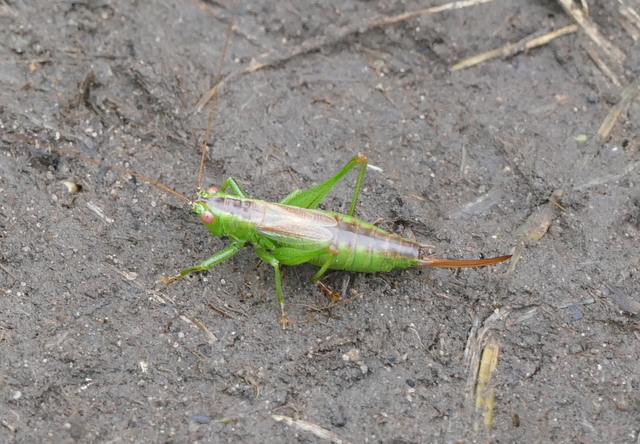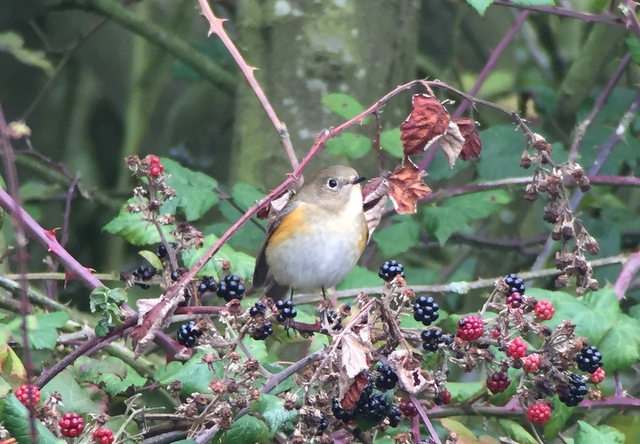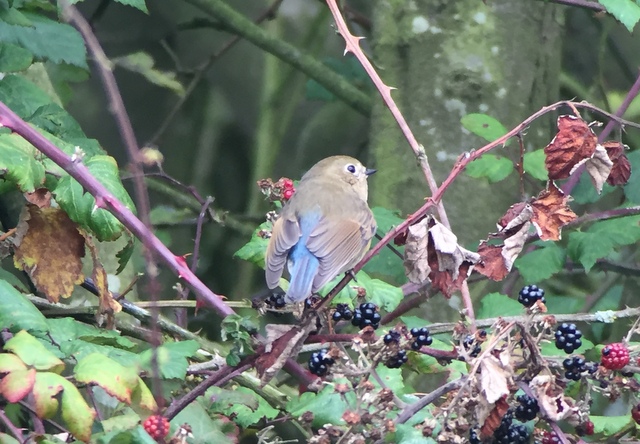Day 1 of a long weekend of tours today. Norfolk has been enjoying a real purple patch in the last week, with a succession of rare vagrants from the east turning up in the county, brought to us on an ongoing easterly airflow originating from far across onto the continent. We set out to try to catch up with a few of those today.
Our first stop saw us drive east along the coast to Beeston Common, just beyond Sheringham. It was overcast and blustery when we arrived, but that doesn’t seem to put off our first target. As soon as we got out onto the Common we could see the Isabelline Shrike perched atop a hawthorn bush, looking all around. We got it in the scope and watched it catch a wasp and eat it.
 Isabelline Shrike – still present on Beeston Common today & showing well
Isabelline Shrike – still present on Beeston Common today & showing well
Suddenly it flew towards us, and landed in another bush much closer by. It was obviously actively looking for food, as it flew again to another perch. It dropped sharply down to the ground, but disappeared deep into a holly when it flew back out so we couldn’t see what it had caught this time. We waited a few minutes and it reappeared on our side of the holly, before flying across back to the hawthorn it had just come from.
From there, it dropped down into the grass again and this time flew up with a small frog. It took it into the hawthorn and we could just see it through the scope, impaling the frog on a thorn. Shrikes are also traditionally known as ‘butcher birds’, as they will store excess food in a ‘larder’ by impaling them on a thorny bush or even barbed wire for later consumption. The Isabelline Shrike seemed unsure whether to eat its frog now or leave it for later. It appeared to eat a little, then moved back to the outside of the bush to resume hunting, before changing its mind and dropping back in to eat some more. Fascinating to watch.
There have been thrushes arriving in numbers for days now, and out on the common we saw a Blackbird or two drop into the bushes and a large flock of Redwing flew over our heads calling. A Sparrowhawk flew over as well – there is a real bounty for predators at the moment, with many small birds arriving here exhausted from the continent.
Having enjoyed such great views of the Isabelline Shrike, we decided to move on and try our luck elsewhere. Heading back west along the coast, we stopped at Muckleburgh Hill next. An Olive-backed Pipit had been found here yesterday, but it had been very elusive. They have a habit of creeping surreptitiously through the grass unseen, so it seemed like it might be difficult for us to see this one. A text message also confirmed that it had been elusive so far this morning. We thought we might as well have a go.
When we finally found the assembled crowd, the Olive-backed Pipit was on show, but getting everyone onto it was easier said than done at first. It was creeping around on an area of cut bracken, amongst the dead stalks and short regrowth, so had lots of places to hide. We kept getting glimpses of it. Frustrating. Finally it crept over to a more obvious place under a large rowan tree and proceeded to work its way round the edge of the taller bracken at its base. Now everyone got onto it, we managed to get it in the scopes and get some cracking views.
 Olive-backed Pipit – eventually showed very well at Muckleburgh Hill
Olive-backed Pipit – eventually showed very well at Muckleburgh Hill
Olive-backed Pipits breed in Siberia and just into European Russia, migrating down to India and south Asia for the winter. They are a rare visitor to our shores, though they turn up more often these days than they used to. They are still a great bird to see and full of character, as they creep around pumping their tails slowly up and down.
We left the crowd to it, and continued our way back west, stopping off next at Stiffkey Greenway. A Great Grey Shrike had been seen earlier in the morning, but had disappeared off to the west along the coastal path. There were lots of people here, birdwatchers as well as dog walkers and joggers, so we didn’t fancy our chances of seeing it. This is a good site to look for other recent arrivals in the coastal bushes, so we decided to go for a walk anyway.
Scanning the saltmarsh, we could see lots of Brent Geese out amongst the vegetation. A Greenshank dropped in on the path out across the marshes and started to feed around the small pools. A Grey Plover was on the path further out and there were lots of Curlew and Redshank. Several of the scattered pools also held a Little Egret.
 Brent Geese – feeding out on the saltmarsh
Brent Geese – feeding out on the saltmarsh
There were not so many birds in the hawthorns and brambles as there have been in the last couple of days. Perhaps fewer new birds had arrived overnight, or possibly they had already moved off inland, disturbed by all the activity up and down the path. We did see plenty of Goldcrests in the bushes, and flushed a steady stream of Redwings, Song Thrushes and Blackbirds. There were several finches – Chaffinches, Greenfinches and Goldfinches, though they were keeping down in the bushes out of the wind. We caught up with a tit flock – Long-tailed Tits and Blue Tits – working their way through the gorse around the whirligig. In amongst them we found a couple of Chiffchaff.
We only went as far as the eastern track at Warham Greens. As we walked out at the whirligig, a small falcon swept up along the edge of the saltmarsh and powered away behind us, a Merlin. We scanned the marshes out towards East Hills and initially picked up nothing more than a couple of distant Marsh Harriers. Then a smaller, sleeker, slimmer-winged harrier swept up above the horizon briefly before dropping back down and resuming quartering low over the vegetation. Through the scopes we could see the paler underparts and square white patch at the base of the tail – its was a young ringtail Hen Harrier.
With no sign of the shrike and time getting on towards lunch, we decided to walk back. On the way, we stopped briefly to admire a bush cricket which walked out onto the muddy path – a Short-winged Conehead.
 Short-winged Conehead – a type of bush cricket, on the coastal path
Short-winged Conehead – a type of bush cricket, on the coastal path
We ate lunch at Lady Anne’s Drive and afterwards walked west along the path on the inner edge of the pines. It was fairly quiet at first, apart from the ubiquitous Goldcrests and the regular Little Grebes on the pool at Salts Hole. Just beyond there, we could see some other birders on the top of a low bank, scanning the bushes in the reeds by the path. There has been another Isabelline Shrike here at Holkham in the last few days (there have been an unprecedented three in Norfolk!), but apparently we had just missed it. It had dropped down from one of the bushes and disappeared. We decided to walk a little further along to the gate, from where we could scan the grazing marshes.
There was no sign of the shrike from further along either, but we did see a rather late Common Whitethroat in a low rose bush by the gate. There are lots here in the summer, but this one should probably be well on its way towards Africa by now. Out on the grazing marshes, we could see a few Pink-footed Geese together with the Greylags. It was while we were scanning the marshes, that someone coming along the path broke the news to us that the shrike had reappeared further back along the path.
We walked back quickly and there it was – perched up in a wild rose bush amongst the reeds, our second Isabelline Shrike of the day. How greedy! It was rather similar to the one that we had seen at Beeston Common in the morning, but noticeably more extensively marked with dark chevrons on its pale underparts. There is typically some variation between individuals.
 Isabelline Shrike – our second of the day, at Holkham
Isabelline Shrike – our second of the day, at Holkham
When it flew down again, we continued on our way west along the path. We stopped periodically to scan through the Goldcrests, in case there might be something more interesting in amongst them. It has been amazing just how many there were here in recent days – it would be fascinating to know how many have come in from the continent and moved on inland this week.
Just past the crosstracks, we came to the clump of sallows which the Red-flanked Bluetail has been frequenting, since Monday at least. There is always something of a dilemma – whether to try to see it flicking around quietly in the sallows, or whether to wait our by the brambles where it likes to come to feed on blackberries occasionally. We decided on the latter.
We didn’t have to wait too long until the Red-flanked Bluetail put in a typically brief appearance on the brambles. It perched for a few seconds feeding on the blackberries, but it was mostly hidden within the foliage. Then it flew across the front. Most of the group got a glimpse – a flash of the blue tail as it went. We waited again and then got a repeat performance – the Bluetail fed on a blackberry from within the brambles and then flashed off. It was clearly nervous – the local Robins have been giving it a hard time, chasing it away.
 Red-flanked Bluetail – showing off its orange flank patches
Red-flanked Bluetail – showing off its orange flank patches
Finally, on its third visit of our vigil, the Red-flanked Bluetail came out onto the brambles in full view. We could see its rather Robin-like appearance front on, but lacking the red (orange!) breast and instead sporting two orange flank patches and a triangular white throat patch. We were missing its best feature from this angle, but it even did the decent thing and turned round, flashing its bright blue tail at us. What a cracker! Than it darted off back into the sallows.
 Red-flanked Bluetail – helpfully turned around to show off its bright blue tail
Red-flanked Bluetail – helpfully turned around to show off its bright blue tail
Red-flanked Bluetails breed in the Siberian taiga and migrate down to spend the winter in SE Asia. They were almost a mythical rarity in the UK in years gone by but only in the last 10-15 years have they become annual visitors and are now almost an expected find after a period of east winds at this time of year. This is probably because they have been expanding their breeding range steadily westwards and now breed in eastern Finland. Still, that does not detract at all from the delight at seeing one – electric blue tail, and all.
After great views such as those, we set off back suitably elated. Once again, we paused regularly to check through the flocks of Goldcrests and tits on the way back. Two Swallows hawking for insects low over the pines around Washington Hide were another unseasonal surprise, with most of their brethren well on their way to Africa by now.
There had been a Pallas’s Warbler in the trees further along from Lady Anne’s Drive towards Wells during the day, so we thought we might walk that way and try to see it. Unfortunately, the weather started to close in a little on our way back and the light levels dropped early. The trees where the Pallas’s Warbler had been were quiet. It had been a tiring day in the field and energy levels were waning by this stage, so we decided to make our way slowly back. But what a day it had been – 2 Isabelline Shrikes, Olive-backed Pipit and Red-flanked Bluetail amongst others. We needed to leave something for tomorrow!
















